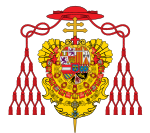Luis de Borbon y Farnesio

Luis Antonio Jaime de Borbón y Farnesio (born July 25, 1727 in Madrid , † August 7, 1785 in Arenas de San Pedro , province of Ávila ) was the sixth and thus youngest son of King Philip V and thus Infanta of Spain. His mother was the second wife of Philip V, Elisabetta Farnese , Duchess of Parma ; he himself was the younger brother of the Spanish King Charles III. (r. 1759-1788).
biography
Since Don Luis de Borbón had no prospect of succession to the throne, his family chose an ecclesiastical career for him. Although since the Council of Trent (1545–1563) the granting of patronage rights as a personal benefit ( ex gratia ), i. H. was forbidden without the actual exercise of the church office, he was - after long negotiations with the Roman Curia - already at the age of eight (1735) by Pope Clement XII. appointed Cardinal and Archbishop of Toledo . Six years later (1741) he was appointed Archbishop of Seville , so that he was financially secure.
However, since as a grown man he had no inclination towards a church career and was more interested in art and music as well as in hunting and the art of fencing, in 1754 he gave up all his ecclesiastical dignities and thus a large part of the income resulting from it - However, he was left with an annual compensation payment i. H. v. 946,107 reals from the revenues of the Archdiocese of Toledo Nothing is known about his activities in the following seven years. In 1761 he acquired the manorial power over the city of Boadilla del Monte at the gates of Madrid for the price of nearly 1.2 million reales as well as the neighboring county of Chinchón .
In Boadilla del Monte he had his friend, architect Ventura Rodríguez, build a representative residence in the years 1761–1765 - the Palacio del Infante don Luis , where he lived an art-loving bachelor life and welcomed artists (including Francisco de Goya ) as guests and interlocutors . From 1770 Luigi Boccherini was officially “composer and chamber virtuoso” (Italian compositore e virtuoso di camera ; Spanish compositor y virtuoso de cámara ) of Don Luis, for whom he created numerous works (until his death).
A few years after his unsuitable love marriage with the sixteen-year-old María Teresa de Vallabriga in 1776 or shortly afterwards, the almost 50-year-old Luis de Borbón and his family moved into the Palacio de la Mosquera in Arenas de San Pedro in, also designed by Ventura Rodríguez the province of Avila , which, however, was not yet fully completed. His young wife bore him three children, all of whom were excluded from the line of succession and were only allowed to approach the Spanish court within a distance of 20 iguanas .
Luis de Borbón died on August 7, 1785 and was buried in the chapel of his palace in Boadilla del Monte. In 1800 his remains were transferred to the Escorial Pantheon .

progeny
- Luis María de Borbón y Vallabriga (1777–1823) - 14th Count of Chinchón, then Archbishop of Toledo and cardinal; buried in the Cathedral of Toledo
- María Teresa de Borbón y Vallabriga (1780–1828) - after her brother's resignation, the 15th Countess of Chinchón and 1st Marquesa of Boadilla del Monte; ∞ Manuel de Godoy ; buried in the chapel of the Palacio del Infante don Luis
- María Luisa de Borbon y Vallabriga (1783-1848); ∞ Joaquín José de Melgarejo y Saurín , Duke of San Fernando de Quiroga; also buried in the chapel of his father's palace
ancestors
| Louis XIV , King of France (1638–1715) | |||||||||||||
| Louis de Bourbon Dauphin of France (1661–1711) | |||||||||||||
| Maria Teresa of Spain (1638–1683) | |||||||||||||
| Philip V King of Spain (1683–1746) | |||||||||||||
| Ferdinand Maria , Elector of Bavaria (1636–1679) | |||||||||||||
| Maria Anna of Bavaria (1660–1690) | |||||||||||||
| Henriette Adelheid of Savoy (1636–1676) | |||||||||||||
| Luis de Borbon y Farnesio | |||||||||||||
| Ranuccio II Farnese (1630-1694) | |||||||||||||
| Odoardo II Farnese (1666-1693) | |||||||||||||
| Isabella d´Este (1635–1666) | |||||||||||||
| Elisabetta Farnese (1692–1766) | |||||||||||||
| Philipp Wilhelm , Elector Palatinate (1615–1690) | |||||||||||||
| Dorothea Sophie of the Palatinate (1670–1748) | |||||||||||||
| Elisabeth Amalie of Hessen-Darmstadt (1635–1709) | |||||||||||||
literature
- José Luis Vila-San-Juan: Los Borbones en España - Cunas, bodas y mortajas. Plaza & Janés, Barcelona 1998, ISBN 84-01-55011-4 .
Web links
Individual evidence
- ^ Remigio Coli: Luigi Boccherini. La vita e le opere , Maria Pacini Fazzi Editore: Lucca 2005, ISBN 88-7246-679-2 , p. 94
| personal data | |
|---|---|
| SURNAME | Borbón y Farnesio, Luis de |
| ALTERNATIVE NAMES | Borbón y Farnesio, Luis Antonio Jaime de (full name) |
| BRIEF DESCRIPTION | Infante of Spain, sixth son of King Philip V |
| DATE OF BIRTH | July 25, 1727 |
| PLACE OF BIRTH | Madrid |
| DATE OF DEATH | August 7, 1785 |
| Place of death | Arenas de San Pedro |

